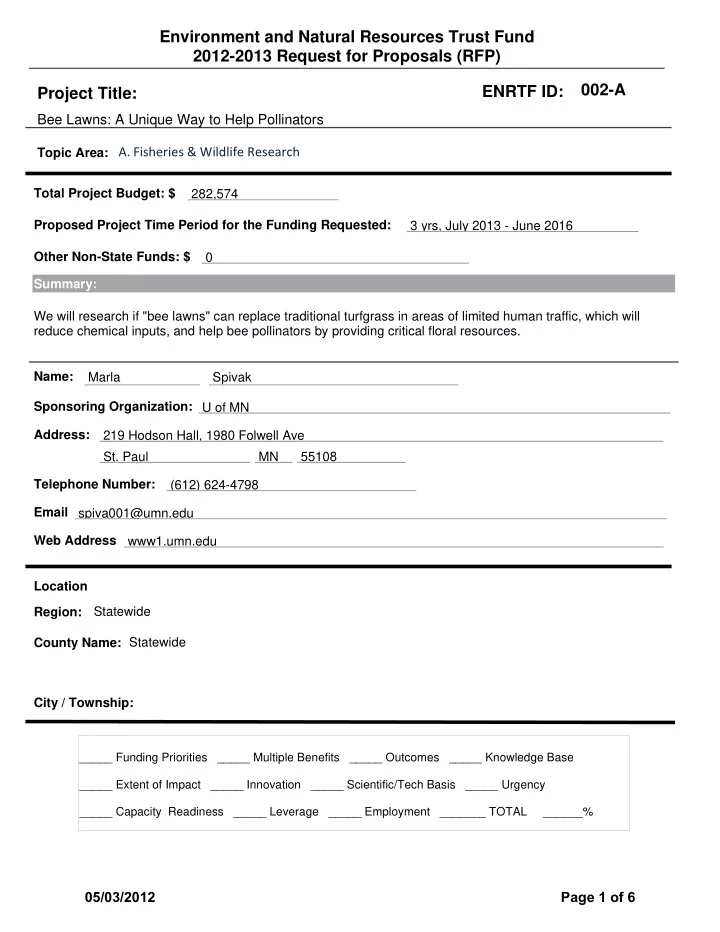

Environment and Natural Resources Trust Fund 2012-2013 Request for Proposals (RFP) 002-A ENRTF ID: Project Title: Bee Lawns: A Unique Way to Help Pollinators A. Fisheries & Wildlife Research Topic Area: Total Project Budget: $ 282,574 Proposed Project Time Period for the Funding Requested: 3 yrs, July 2013 - June 2016 Other Non-State Funds: $ 0 Summary: We will research if "bee lawns" can replace traditional turfgrass in areas of limited human traffic, which will reduce chemical inputs, and help bee pollinators by providing critical floral resources. Name: Marla Spivak Sponsoring Organization: U of MN Address: 219 Hodson Hall, 1980 Folwell Ave St. Paul MN 55108 Telephone Number: (612) 624-4798 Email spiva001@umn.edu Web Address www1.umn.edu Location Statewide Region: County Name: Statewide City / Township: _____ Funding Priorities _____ Multiple Benefits _____ Outcomes _____ Knowledge Base _____ Extent of Impact _____ Innovation _____ Scientific/Tech Basis _____ Urgency _____ Capacity Readiness _____ Leverage _____ Employment _______ TOTAL ______% 05/03/2012 Page 1 of 6
PROJECT TITLE: Bee Lawns: A Unique Way to Help Pollinators I. PROJECT STATEMENT The goal of our proposed research is to develop an innovative way of helping bee pollinators while enhancing the environment and protecting natural resources. We are seeking options for turf areas that are not used for human recreation but are still maintained by mowing and intensive inputs of water, fertilizers and pesticides. Planting bee lawns would reduce these inputs and provide low-growing floral areas, which would beautify Minnesota and provide a creative model for a simple yet effective way to help pollinators and protect our natural resources. Bee pollinators (honey bees, Apis mellifera , and over 400 species of native bees) are in trouble. Bee health is failing across MN and the nation due to a scarcity of bee-friendly flowers leading to nutritional deficiencies, chronic exposure to pesticides, and debilitating diseases, and parasites (Spivak et al., 2011). Bees play a key role in American agriculture through pollination; the U.S. grows more than one hundred crops that either need or benefit from pollinators with an economic value estimated at $20 billion in 2000. The Upper Midwest states, including MN, ND and SD, are the top honey producing states in the nation. Commercial beekeepers transport their colonies to our region for the summer months for honey production after fulfilling pollination contracts in other parts of the nation. People are taking action to rectify the decline of pollinators by becoming beekeepers, reducing pesticide exposure to bees, and planting flowers to support the nutritional needs of all bees. Seed mixtures and designs for bee-friendly flower gardens are becoming prevalent across the nation. We propose to research the potential multiple benefits of a unique type of landscape - bee lawns - to support pollinators and reduce intensive inputs. Turfgrass makes up a significant part of the urban landscape but provides no nutritional resources for pollinators. Some turf areas, such as those in out-of-play roughs on golf courses, cemeteries, large commercial properties and boulevards, are rarely used by people and primarily serve an aesthetic purpose. There is recent interest in the use of lower-input grasses in these turf areas as a way to reduce inputs of water, fertilizer, and pesticides (Watkins et al., 2011). Many of these areas may also be useful as bee lawns; i.e., a low-input turf area that also contains low-growing flowering plants that can be utilized by important bee pollinators. These low- growing flowering plants would need to have characteristics that contribute positively to a sustainable landscape that maintains turf function (slow vertical growth rate, contribution of nitrogen due to nitrogen fixation, ability to vegetatively reproduce in a perennial system, positive aesthetics in urban settings). Bee lawns would provide a natural buffer to water resources in areas where low-growing, more manicured looking lawns are preferred. Although this idea is novel, the use of non-turfgrass species in lawns is not. In the mid-20 th century and before, white clover seed was often included in lawn seed mixtures in order to decrease the need for nitrogen fertilization. Before bee lawns can be recommended, we must research the correct grass-flower combination that would fulfill the requirements of a bee lawn (produces flowers useful to pollinators, contributes nitrogen or other benefits, maintains function and aesthetics of the turf). II. DESCRIPTION OF PROJECT ACTIVITIES Activity 1: Bee Lawn Evaluation Trials Budget: $232,574 We propose to evaluate a series of grasses in mixtures with low-growing flowering plants that can sustain growth within the turf, tolerate mowing and continue flowering after occasional mowing. We will evaluate low-input grasses (Chewings fescues, hard fescue, sheep fescue, tall fescue, and prairie junegrass - a native grass currently being improved for turf use at the University of Minnesota) in mixtures with a series of low-growing, flowering legumes (alfalfa, Kura clover, birdsfoot trefoil, white clover) and native flowering plants (e.g., lanceleaf coreopsis, field mint ( Mentha arvensis ), and blue-eyed grass ( Sisyrinchium angustifolium ). The turf evaluation trial will be established in late summer 2012 on the St. Paul campus of the Univ. MN and at the MN Landscape Arboretum. A total of at least 25 turfgrass-flowering plant combinations will be included (we will select mixture combinations and ratios based on input from industry and university contacts familiar with these flowering species); plots will be planted in four replications in a randomized complete block design. Data will be collected through fall 2015 on overall turf quality, floral abundance, amount and type of bee visitation (honey bee and native bees), freedom from turfgrass diseases, and the ratio of grass to floral mixture over the years. Data will be analyzed to determine the top-performing mixtures. 05/03/2012 Page 2 of 6
Recommend
More recommend